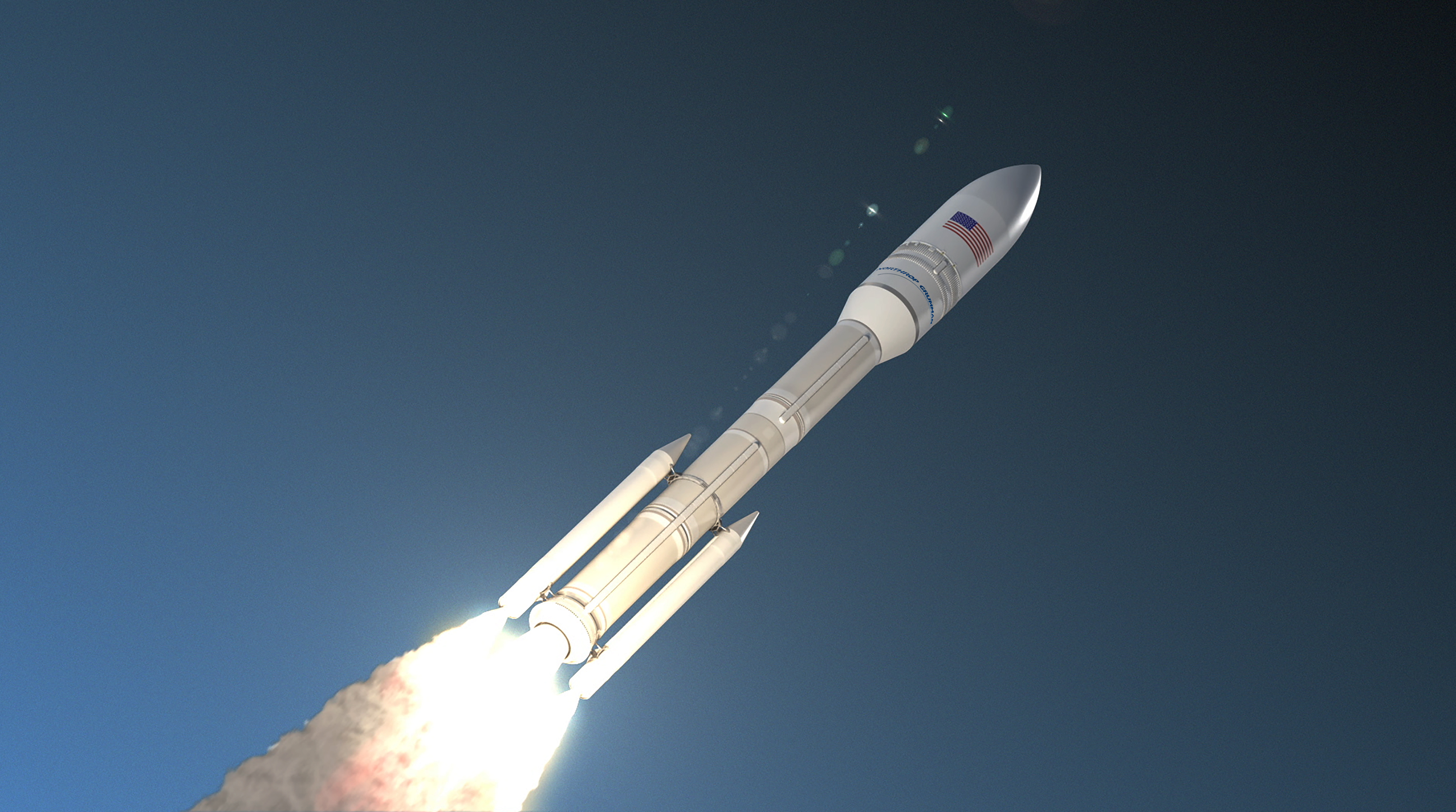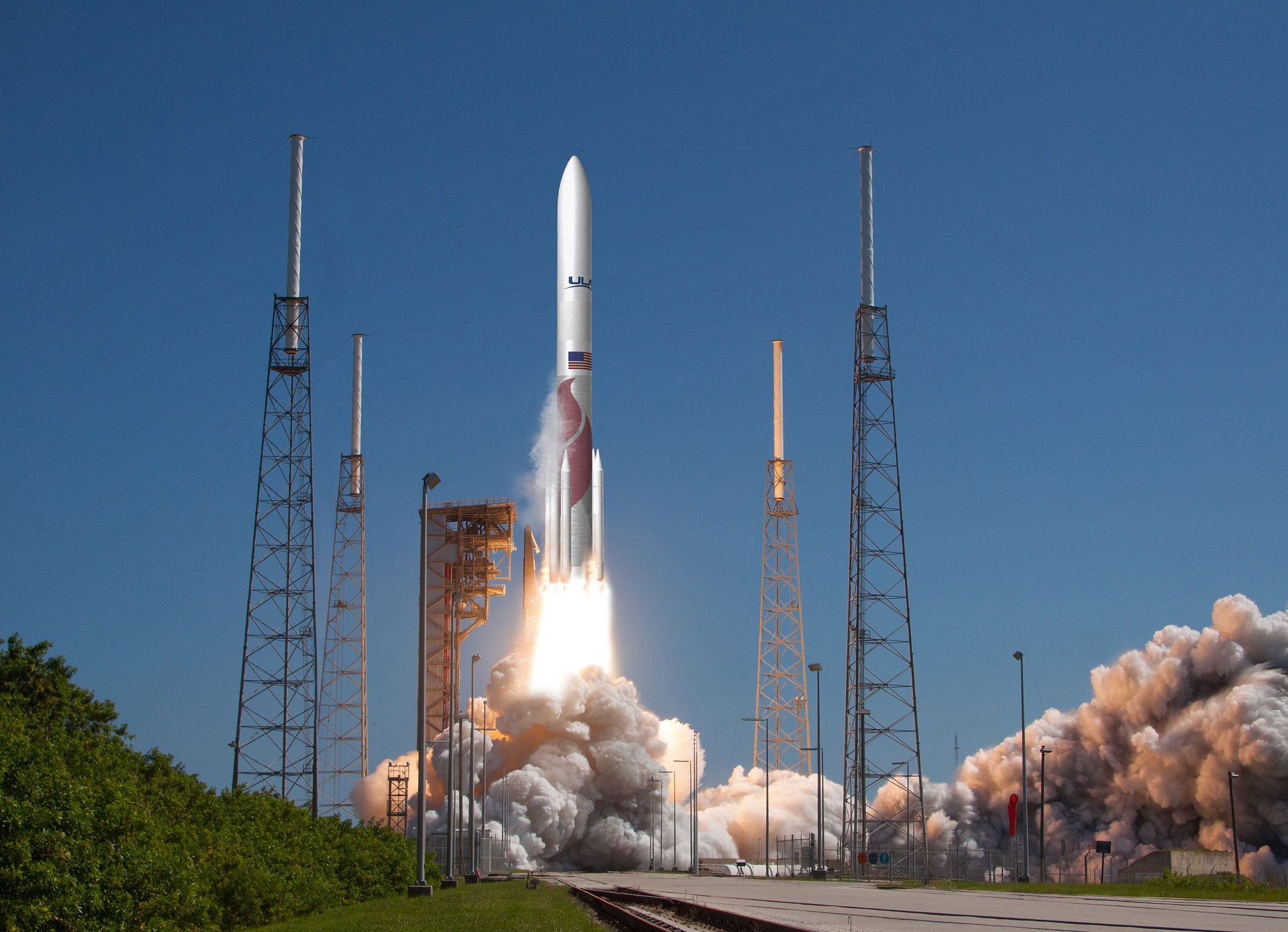3 New Rockets Are on Track for 1st Test Flights in 2021
Meet OmegA, the Vulcan Centaur and New Glenn.
COLORADO SPRINGS, Colo. — Three new commercial rockets are on track to make their first test flights in 2021. But they may not all make it to the launch pad, depending on who wins a competition for a contract with the U.S. Department of Defense.
The U.S. Air Force is about to decide which two companies will receive contracts to launch 25 military satellites between 2022 and 2026. In the running are Northrop Grumman's OmegA rocket, the United Launch Alliance (ULA) Vulcan Centaur rocket and Blue Origin's reusable New Glenn heavy-lift rocket. SpaceX is also eligible for the award, even though that company did not receive a Launch Service Agreement (LSA) award along with the other three contestants in October. If SpaceX wins, it would use its Falcon 9 and Falcon Heavy rockets to launch the national security missions.
"We are very confident that we will be flying in 2021," ULA Chief Executive Tory Bruno said about the company's Vulcan rocket in a news conference here at the 35th Space Symposium on Monday (April 8). That same day, Northrop Grumman Vice President for Strategic Programs (and former NASA astronaut) Kent Rominger said that progress on the OmegA rocket has exceeded the company's expectations. Blue Origin did not provide any updates on New Glenn at Space Symposium, but the company has already expressed some confidence in its timeline by signing contracts to launch commercial satellites starting in 2021.
Related: The World's Tallest Rockets: How They Stack Up
Blue Origin's New Glenn is a reusable heavy-lift rocket that is designed to make upright landings, much like SpaceX's Falcon 9 rockets. In January, Blue Origin revealed a new digital mock-up of the company's newly redesigned New Glenn rocket. The two-stage rocket stands 270 feet (82 m) tall and is powered by seven BE-4 engines.
The Vulcan's first test flight is currently slated for April 2021. Until then, ULA plans to test some technology for the company's new Vulcan rocket by flying that tech on the Atlas V, a reliable rocket that ULA has been launching since 2002, Bruno said. So, the Vulcan would have flight-proven hardware even on its first test flight. Two BE-4 rocket engines provided by Blue Origin will power the rocket's first-stage booster, and the Vulcan's upgraded Centaur upper stage will use RL10 cryogenic engines built by Aerojet Rocketdyne.

Like ULA, Northrop Grumman is also targeting the first flight of its rocket, the OmegA, for sometime in 2021. The company is planning to conduct a test-fire of the OmegA rocket's first stage on May 31, followed by a test of the rocket's upper stage in August, Rominger said. Northrop Grumman will first launch its intermediate-class version of the rocket in 2021, followed by a test launch of the heavy-lift version in 2024. Although this 196-foot (60 meters) rocket is designed to launch payloads into Earth orbit, it will be powerful enough to also launch missions into lunar orbit, Rominger said.
Get the Space.com Newsletter
Breaking space news, the latest updates on rocket launches, skywatching events and more!
While SpaceX's three competitors are making brand-new rockets, SpaceX is the only company that would be launching the military satellites on flight-proven rockets: the Falcon 9, which already has nearly 70 missions under its belt, and the Falcon Heavy, which launched its first commercial mission on April 11. So, while SpaceX doesn't need to develop a new kind of rocket for this competition, the company's three competitors are hard at work to get their new launch vehicles ready for liftoff by 2021 with the hopes of being contracted to start launching military satellites in 2022.

Northrop Grumman, ULA and Blue Origin received a combined $2 billion in funding from the U.S. Air Force in October to help pay for the development of next-generation rockets designed to launch intermediate- and heavy-class military satellites. For Phase 2 of the selection process, known as Launch Service Procurement (LSP), contestants will submit their proposals to the Air Force this spring, with the winners announced in 2020.
The two winners of the competition will be contracted to launch a total of 25 military satellites between 2022 and 2026. One of the companies will launch 15 of those missions, and the other will launch 10. Along with those launch contracts, the Air Force will award funding for the continued development of the new rockets.
If awarded the contract, Blue Origin would receive $500 million for New Glenn, Northrop Grumman would receive $792 million for OmegA and ULA would receive $967 million for the Vulcan Centaur, according to the LSA contracts the companies won in October. Because SpaceX did not receive a LSA award, we won't know how much the Department of Defense will offer that company until (or if) it is selected in the LSP competition in 2020.
If Northrop Grumman does not win an LSP award next year, it's unclear whether the company will be able to continue developing the OmegA rocket. There is a chance that work on OmegA would be discontinued without funding from the Air Force, Rominger told SpaceNews.
On the other hand, Blue Origin — whose founder and CEO is the richest person in the world — may be better-poised to fund the development of its own rocket if the company does not win the Air Force contract. ULA appears to be in a pretty good position to win the contract. The company has the longest track record of military launches of any launch provider in the United States, and it held a monopoly on that service until SpaceX won its first contract with the Department of Defense in 2016. Blue Origin has argued that ULA has an unfair advantage given the short timeline for developing these new rockets and has asked the Air Force to extend its deadlines to level out the playing field. So far, the Air Force hasn't delayed the competition.
Even though the three companies that won LSA awards say they are on track to launch in 2021, whether they launch on time (or at all) may depend on if they continue to receive funding from the Department of Defense. The companies that aren't selected to launch those 25 military satellites will be cut off from the funding they have been receiving as part of those LSA awards.
If the companies that don't make the cut are able to continue developing their rockets without that extra funding, those rockets may not be used to launch any military satellites, but they could still launch commercial payloads into orbit around the Earth and possibly even to the moon. According to Rominger, Northrop Grumman's OmegA rocket is powerful enough to launch a 20,000-lb. (9,000 kilograms) payload into orbit, even though that's not what the rocket was designed to do. Rominger said Northrop Grumman would be open to more possibilities for OmegA in the future, but for now, the company is focused on national security missions.
Whatever happens with the Air Force's selection process over the coming months, one thing is certain — 2021 is going to be a historic year for commercial and military space launches. May the best rockets win!
- Air Force Space Launch Competition Caught in Political Crossfire
- EELV Is No More. It Is Now 'National Security Space Launch'
- Air Force Open to Reusable Rockets, But SpaceX Must First Demonstrate Performance
Email Hanneke Weitering at hweitering@space.com or follow her @hannekescience. Follow us on Twitter @Spacedotcom and on Facebook.
Join our Space Forums to keep talking space on the latest missions, night sky and more! And if you have a news tip, correction or comment, let us know at: community@space.com.

Hanneke Weitering is a multimedia journalist in the Pacific Northwest reporting on the future of aviation at FutureFlight.aero and Aviation International News and was previously the Editor for Spaceflight and Astronomy news here at Space.com. As an editor with over 10 years of experience in science journalism she has previously written for Scholastic Classroom Magazines, MedPage Today and The Joint Institute for Computational Sciences at Oak Ridge National Laboratory. After studying physics at the University of Tennessee in her hometown of Knoxville, she earned her graduate degree in Science, Health and Environmental Reporting (SHERP) from New York University. Hanneke joined the Space.com team in 2016 as a staff writer and producer, covering topics including spaceflight and astronomy. She currently lives in Seattle, home of the Space Needle, with her cat and two snakes. In her spare time, Hanneke enjoys exploring the Rocky Mountains, basking in nature and looking for dark skies to gaze at the cosmos.









